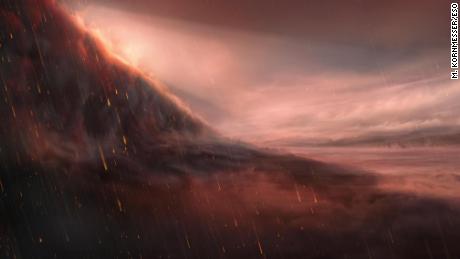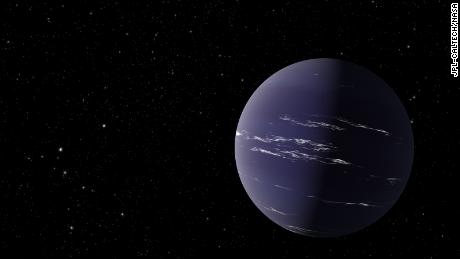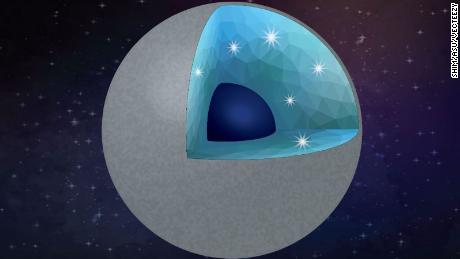Weird and wonderful planets beyond our solar system
An artists's conception shows planet LP 791-18d. The volcanically active planet, which is a similar size to Earth, was discovered by NASA's Spitzer Space Telescope.
Weird and wonderful planets beyond our solar system
This artist's illustration depicts the rocky exoplanet GJ 486 b, which orbits a red dwarf star located 26 light-years away from Earth. Astronomers have detected hints of water vapor in the system, but they can't be sure if it signifies a planetary atmosphere or if it's part of the star.
Weird and wonderful planets beyond our solar system
This illustration shows an Earth-size exoplanet called TOI 700 e, discovered orbiting the small, cool M dwarf star TOI 700, which is located 100 light-years away. Its other Earth-size sibling, TOI 700 d, can be seen in the distance.
Weird and wonderful planets beyond our solar system
TOI 700 d is the first potentially habitable Earth-size planet spotted by NASA's planet-hunting TESS mission.
Weird and wonderful planets beyond our solar system
Artist's impression of the exoplanet WASP-121 b. It belongs to the class of hot Jupiters. Due to its proximity to the central star, the planet's rotation is tidally locked to its orbit around it. As a result, one of WASP-121 b's hemispheres always faces the star, heating it to temperatures of up to 3000 degrees Celsius. The night side is always oriented towards cold space, which is why it is 1500 degrees Celsius cooler there.
Weird and wonderful planets beyond our solar system
This artist's impression shows a close-up view of Proxima d, a planet candidate recently found orbiting the red dwarf star Proxima Centauri, the closest star to the Solar System. The planet is believed to be rocky and to have a mass about a quarter that of Earth. Two other planets known to orbit Proxima Centauri are visible in the image too: Proxima b, a planet with about the same mass as Earth that orbits the star every 11 days and is within the habitable zone, and candidate Proxima c, which is on a longer five-year orbit around the star.
Weird and wonderful planets beyond our solar system
The discovery of a second exomoon candidate hints at the possibility that exomoons may be as common as exoplanets.
Weird and wonderful planets beyond our solar system
This artist's impression shows the football-shaped planet WASP-103b (left) closely orbiting its host star.
Weird and wonderful planets beyond our solar system
This image shows double-star system b Centauri and its giant planet b Centauri b. The star pair is the bright object at top left. The planet is visible as a bright dot in the lower right. The other bright dot (top right) is a background star.
Weird and wonderful planets beyond our solar system
This artist's rendering shows a Jupiter-like planet orbiting a dead white dwarf star 6,500 light-years away from Earth. The planet survived the violent phases of stellar evolution leading to the star's death.
Weird and wonderful planets beyond our solar system
This artist's illustration shows the night-side view of the exoplanet WASP-76b, where iron rains down from the sky.
Weird and wonderful planets beyond our solar system
Astronomers have identified a new class of habitable planets, which they call Hycean planets. These are hot, ocean-covered planets with hydrogen-rich atmospheres.
Weird and wonderful planets beyond our solar system
This artist's illustration shows L 98-59b, one of the planets in a planetary system 35 light-years away from Earth. This planet has half the mass of Venus.
Weird and wonderful planets beyond our solar system
In this artist's illustration, two gaseous exoplanets can be seen orbiting the bright sun-like star HD 152843.
Weird and wonderful planets beyond our solar system
An artist's rendering of TOI-1231 b, a Neptune-like planet about 90 light years away from Earth.
Weird and wonderful planets beyond our solar system
This artist's conception depicts a violent flare erupting on the star Proxima Centauri as seen from the viewpoint of a planet orbiting the star called Proxima Centauri b.
Weird and wonderful planets beyond our solar system
After losing its gaseous envelope, the Earth-size core of an exoplanet formed a second atmosphere. It's a toxic blend of hydrogen, methane, and hydrogen cyanide that is likely fueled by volcanic activity occurring beneath a thin crust, leading to its cracked appearance.
Weird and wonderful planets beyond our solar system
This illustration shows the metaphorical measuring of the density of each of the seven planets in the nearby TRAPPIST-1 system. New measurements have revealed the most precise densities yet for these planets and they're very similar -- which means they also likely have similar compositions.
Weird and wonderful planets beyond our solar system
This artist's illustration shows the view from the furthest planet in the TOI-178 system.
Weird and wonderful planets beyond our solar system
This artist's illustration shows TOI-561b, one of the oldest and most metal-poor planetary systems discovered yet in the Milky Way galaxy. Astronomers found a super-Earth and two other planets orbiting the star.
Weird and wonderful planets beyond our solar system
This massive and distant exoplanet, called HD106906 b, has an elongated and angled orbit that causes it to take 15,000 Earth years to complete one lap around its twin stars.
Weird and wonderful planets beyond our solar system
This is an artist's impression of a free-floating rogue planet being detected in our Milky Way galaxy using a technique called microlensing. Microlensing occurs when an object in space can warp space-time.
Weird and wonderful planets beyond our solar system
This is an artist's impression of exoplanet WASP-189 b orbiting its host star. The star appears to glow blue because it's more than 2,000 degrees hotter than our sun. The planet, which is slightly larger than Jupiter, has a tilted orbit around the star's poles rather than its equator.
Weird and wonderful planets beyond our solar system
For the first time, an exoplanet has been found orbiting a dead star known as a white dwarf. In this artist's illustration, the Jupiter-sized planet WD 1856 b orbits the white dwarf every day and a half.
Weird and wonderful planets beyond our solar system
This illustration shows a carbon-rich planet with diamond and silica as ts main minerals. Water can convert a carbon-rich planet into one that's made of diamonds. In the interior, the main minerals would be diamond and silica (a layer with crystals in the illustration). The core (dark blue) might be made of an iron-carbon alloy.
Weird and wonderful planets beyond our solar system
This image shows a young sun-like star being orbited by two gas giant exoplanets. It was taken by the SPHERE instrument on European Southern Observatory's Very Large Telescope. The star can be seen in the top left corner, and the planets are the two bright dots.
Weird and wonderful planets beyond our solar system
This artist's impression shows a Neptune-sized planet in the Neptunian Desert. It is extremely rare to find an object of this size and density so close to its star.
Weird and wonderful planets beyond our solar system
This is an artist's impression of the multiplanetary system of newly discovered super-Earths orbiting a nearby red dwarf star called Gliese 887.
Weird and wonderful planets beyond our solar system
The newly discovered exoplanet AU Mic b is about the size of Neptune.
Weird and wonderful planets beyond our solar system
This artist's impression shows a view of the surface of the planet Proxima b orbiting the red dwarf star Proxima Centauri, the closest star to the Solar System. Proxima b is a little more massive than the Earth.
Weird and wonderful planets beyond our solar system
This is an artist's illustration of an exoplanet's atmosphere with a white dwarf star visible on the horizon. The starlight of a white dwarf filtered through the atmosphere of an exoplanet that's orbiting it could reveal if the planet has biosignatures.
Weird and wonderful planets beyond our solar system
This is an artist's illustration of the Kepler-88 planetary system, where one giant exoplanet and two smaller planets orbit the Kepler-88 star. The system is more than 1,200 light-years away.







































































